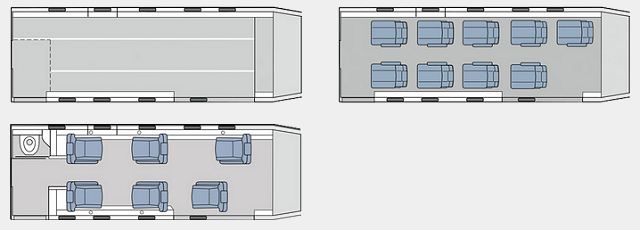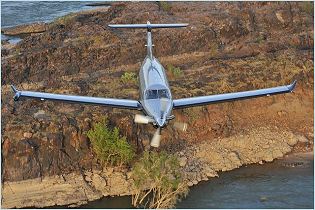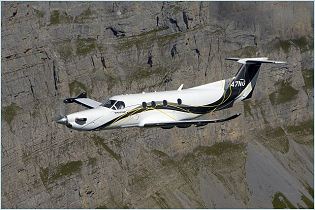PC-12 NG Pilatus
| a | ||||||||||||||||||||||
|
PC-12 NG Pilatus single-engine turboprop passenger - cargo aircraft
|
||||||||||||||||||||||
 |
||||||||||||||||||||||
|
|
||||||||||||||||||||||
|
The Pilatus PC-12 is a single-engine turboprop passenger and cargo aircraft manufactured by Pilatus Aircraft of Switzerland. Pilatus announced the development of the PC-12 at the annual convention of the National Business Aviation Association (NBAA) in October 1989. The two prototypes were completed on 1 May 1991, with the first flight taking place on May 31, 1991. The Pilatus PC-12 NG has gained a reputation for outstanding versatility, performance, reliability and operational flexibility. As such, it is one of the most popular turbine-powered business aircraft on the market today. Over 1200 aircrafts have been sold. In operation around the globe, the PC-12 NG has found popularity in a number of roles– executive transport, cargo, air ambulance, airline, and government special mission applications. |
||||||||||||||||||||||
| Main Variants: | ||||||||||||||||||||||
|
- PC-12/41: Original production variant certified in 1994 has a Pratt & Whitney Canada PT6A-67B engine. Most, if not all of the /41s have been upgraded to /45s.
- PC-12/45: Certified in 1996 has a Pratt & Whitney Canada PT6A-67B engine, maximum takeoff weight increased to 4,500 kg (9,921 lb). - PC-12/47: Certified in 2005 has a Pratt & Whitney Canada PT6A-67B engine, maximum takeoff weight increased to 4,740 kg (10,450 lb). - PC-12/47E: Variant certified in 2008 has upgraded avionics and a Pratt & Whitney Canada PT6A-67P engine. Sometimes known by its trade name PC-12 NG (Next Generation) - PC-12M Spectre: Paramilitary special missions platform marketed in the United States, originally called "Eagle". - U-28A: United States military designation for the PC-12. |
||||||||||||||||||||||
| Technical Data | ||||||||||||||||||||||
| Design | ||||||||||||||||||||||
|
The cabin can be quickly reconfigured for surveillance, transport, combination, medevac, or cargo missions. A standard aft cargo door with a 53” x 52” opening allows the loading of palletized cargo and accommodates up to 2,666 pounds (1,209 kg) of payload with ease. The PC-12 NG can be outfitted with a variety of special-missions equipment, including long-range EO/IR cameras and sensors, all of which can be easily integrated and concealed
|
||||||||||||||||||||||
| Avionics | ||||||||||||||||||||||
|
The PC-12 NG features state-of-the-art Honeywell Primus Apex avionics. Four large displays, including two Primary Flight Displays (PFDs) and two Multi Function Displays (MFDs), provide an unprecedented amount of viewing area and integrate flight information, engine monitoring, aircraft configuration, pressurization, and environmental controls. martView, a proven synthetic vision system, is a revolutionary product which increases safety and situational awareness. It displays a natural 3D rendering of terrain, providing a view that pilots normally see only on a clear day. Flight and weather data, charts, aircraft system information, and trip planning functions are all within easy reach, while a new cockpit environment designed by BMW Group Designworks USA sets a new standard for ergonomics and aesthetics.
|
||||||||||||||||||||||
| Propulsion | ||||||||||||||||||||||
|
The PC-12 NG is powered by the most dependable turboprop engine in the world, the Pratt & Whitney PT6A-67P. A smooth 1,200 shp is delivered for takeoff and climb.
|
||||||||||||||||||||||
| Mission capabilities | ||||||||||||||||||||||
|
Surveillance:
The PC-12 Spectre is particularly well suited for surveillance work, but can also be used for many other purposes. The PC-12 Spectre is the only multipurpose surveillance aircraft to operate within the constraints imposed by dwindling government budgets. Compared to other twin-engine turboprop aircraft, the Spectre is far less costly to buy and less than half as expensive to operate. The standard version of the Spectre retails at around USD 650,000. The PC-12 NG has obtained an STC (Supplemental Type Certificate), and can be equipped with electro-optical and infrared sensors. The sensor system is located in the tailcone and is lowered and retracted as required by a lift device. The two inward-opening doors minimise air resistance and allow 360° visibility when the sensor is lowered. |
||||||||||||||||||||||
 |
||||||||||||||||||||||
|
Air Ambulance:
The PC-12 is an ideal ambulance aircraft, not least for its low operating costs and unique ability to operate in and out of unmade runways. The generous pressurised cabin - over 8 m3 - offers sufficient space and comfort for up to three patients plus medical systems. The large cargo door ensures easy loading and unloading, and the cabin can be reconfigured in line with the mission profile for maximum operator flexibility. |
||||||||||||||||||||||
 |
||||||||||||||||||||||
|
Search & Rescue:
The PC-12 NG features an additional multipurpose utility door. This extra door is integrated within the large cargo door. It gives the PC-12 NG a unique advantage across a wide range of missions: the smaller door allows dropping of e.g. food and aid supplies, or deplaning of skydivers. During this operation the PC-12 NG descends to a height at which there is no need for cabin pressure and the door can be opened. Once the mission is complete, the PC-12 NG climbs back to its cruising altitude. Cabin seats can be installed or removed as required, making the PC-12 NG even more flexible. The combi-version with four seats, for example, offers generous stowage space for aid supplies or auxiliary equipment. |
||||||||||||||||||||||
 |
||||||||||||||||||||||
|
Transport:
The PC-12 NG cargo door is a big plus, allowing easy loading and unloading of bulky or heavy freight. Thousands of hours’ flying in harsh environments have proven that the PC-12 NG’s versatility, high payload and superb quality of construction count amongst the main reasons why it is used by many civilian organisations and government bodies for passenger and cargo transport. Very few aircraft can match the PC-12 NG in terms of operating costs. Depending on the type of cargo, the cabin can be equipped in different configurations. For bulky items, seats can be removed easily and quickly to free up the entire eight cubic metres for stowage. For passenger transport, a nine-seat version offers an exceptionally high level of comfort during the flight. Passengers appreciate the unbeatable benefits of this configuration. A variety of luxury seat options are also available for business use. |
||||||||||||||||||||||
 |
||||||||||||||||||||||
| Specifications | ||||||||||||||||||||||
|
||||||||||||||||||||||
 |
||||||||||||||||||||||
|
||||||||||||||||||||||































